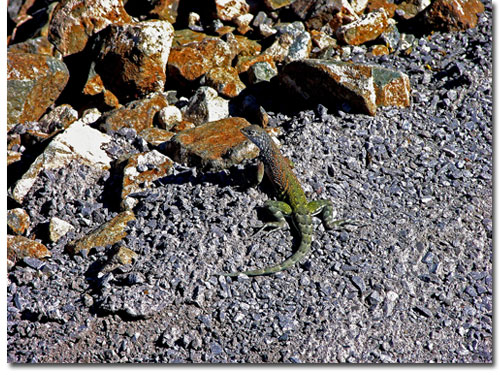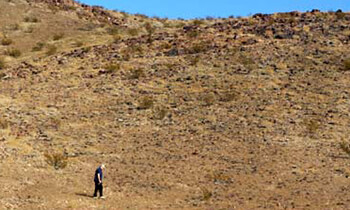Greater Earless Lizard
(Cophosaurus texanus)
by Jay Sharp

“Mad dogs and Englishmen,” said British playwright Noel Coward in his famous ditty of 1932, “go out in the midday sun.” So, too, he might have added, does the greater earless lizard, which seems to relish the midday sun of mid-summer in the rocky, sandy desert terrain of the northern Chihuahuan and northeastern Sonoran Deserts.
Distinctive Features
- Size: About three to seven inches long from the tip of the nose to the tip of the tail; males larger than females.
- Body and Tail: Streamlined shape with a somewhat flattened belly and tail; covered with small granular-like scales.
- Head and Neck: Wedge-shaped with no external ear openings (thus the common name); relatively large eyes; two throat folds.
- Legs: Comparatively thin; forelegs shorter than hind legs; long toes and claws.
- Colors: Head and shoulders, grayish to brownish, like its rocky habitat; upper mid-section, yellow to orange rows; upper hind quarters, yellow to green; legs, dark bands; tail, dark bands across top and heavy dark bars across the underside.
- Distinctive markings: Two heavy black stripes just ahead of hind legs (males); black stripe on the back of each thigh (females and juveniles); pink throat and flanks (pregnant females).
Habitat
The greater earless lizard seems to prefer the middle to higher open desert elevations, especially in rocky mountain foothills that support communities of mesquite, creosote, acacia, cacti and ocotillo plants. It makes frequent appearances along pathways through gravels and sand, and it may take up a watch atop large cobbles. The larger, more mature greater earless lizard may stake out choice habitat, often holding its ground to bask in the sun even as hikers pass nearby.

Greater earless lizard perched on a rock, in its favorite habitat.
Diet
The greater earless lizard preys primarily on the arthropods, including butterflies, moths, beetles, grasshoppers, stinging insects (wasps, bees and ants) and spiders. It may eat the adults or the larvae, with the mature, larger lizard taking the larger prey, and the younger, smaller lizard, the smaller prey.
Life Cycle
In the spring, the lizard begins mating. Every few weeks through the summer, the female lays several eggs in a sand matrix, depositing - then promptly abandoning - her clutch. Within about seven weeks, the young hatch, emerging as 2-inch-long copies of the adults. Immediately, they must fend for themselves, with no parental support. The greater earless lizard reaches sexual maturity at about one year and, with good fortune, lives one to two years. According to Mexico’s Instituto de Ecología, Acta Zoological Mexicana, the lizard reproduces more successfully in years with above-average rainfall because it can capitalize on increased prey.

Greater earless lizard at the edge of a desert hiking path.
Behavior
Emerging in the spring from hibernation, the greater earless lizard promptly becomes one of the most energetic daylight actors of all the wildlife in its range. It opens its day with a vigorous pursuit of insects. It may wave its black-barred tail when preparing to begin or end a dash from rock to rock. It raises its tail, curling it over its back, when scampering. It raises and wags its tail if approached by a predator, a roadrunner, for example, sending notification that it will be caught only after a significant investment of energy in the pursuit. It signals its claim to territory by lateral body compression, head bobbing and pushups.
Temperature Control
As Guy Murchie pointed out in his book The Seven Mysteries of Life, the lizard has a well-honed ability to regulate its body temperature, keeping it very close to its daytime average of 101.5 degrees Fahrenheit most of the time. Needing to raise its temperature, it turns its body broadside to the sun to receive extra rays. Needing merely to maintain its temperature, it aligns its body with the sun to receive reduced rays. Needing to lower its temperature, it takes refuge in shade, or it climbs a branch above the hot ground surface. To escape the coolness of the desert night, it burrows under a warm blanket of sand, capitalizing on its lack of external ear openings to keep grit out of its ear canals.
Interesting Facts
- The greater earless lizard has a higher average “activity temperature” (101.5 degrees Fahrenheit) than most lizards (typically, 80 to 95 degrees Fahrenheit), which helps explain its love for the desert sun.
- The greater earless lizard may save its life by sacrificing its wagging and distracting barred tail to a pursuing predator. The tail, which breaks off easily, will regenerate, although probably shorter in length and more faded in color.
- Males develop especially bright colors, primarily blue, green and yellow, in the spring and early summer. Females develop bright colors, typically pink or orange, during pregnancy.
- The lesser earless lizard, a close relative, occurs from the northern Chihuahuan and northeastern Sonoran Deserts northeastward into the Great Plains. Smaller than the greater earless lizard, it bears several distinguishing rows of blotches along its back, from the neck to the tail. Usually, it is less active during the mid-day heat.
- The zebra-tailed lizard, which looks similar to the greater earless lizard, occurs from northern Mexico across the Southwest into the southern Great Basin. Approximately the same size as the greater earless lizard, it bears distinguishing black bars just behind the front legs and distinctive (zebra-like) black rings around its tail.
- The greater earless lizard belongs to the Squamata order of reptiles, which has 6000 species including some that measure about 1/2 inch in length and others, some 30 feet in length.
Read about more lizards:
Share this page on Facebook:
The Desert Environment
The North American Deserts
Desert Geological Terms







